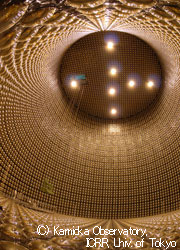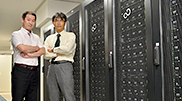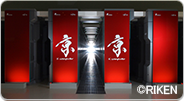Archived content
NOTE: this is an archived page and the content is likely to be out of date.
"Super-Kamiokande," Institute for Cosmic Ray Research, University of Tokyo

To correct, analyze and manage the resultant massive amount of data (approx. 500 GB per day) from over 11,000 photomultiplier tubes, a high-spec PRIMERGY-based system (with 142 blade servers) and a high-performance file system (using the scalable file system software "FEFS") have been installed.
This system, provided by Fujitsu, simultaneously delivers the high reliability required for constant observation, along with the high performance required for analyzing large volumes of data.
Subterranean system:
The real-time, "subterranean system" demands high operational uptime. It is connected to the experiment observation system through a dedicated interface, and performs data collection and format conversion. Additionally, the system is designed so that experimental observational data is not lost, even if communication with the "surface system" data servers is lost. This provides a "backup" competency for collected data from events that cannot be observed a second time.
Surface system:
The "surface system" accumulates and analyzes observational data sent from the subterranean system (approx. 500 GB per day). The software running on the data analysis units removes unneeded event data and stores the observational data on the data servers.
Detailed event reconstruction software is then used to select and reconstruct neutrino events, utilizing the data stored on the data servers. Physical analysis is performed on the events selected to gain a more in-depth understanding of the properties and nature of neutrinos. This requires high CPU processing performance and high speed data access.
In order to provide high-speed parametric analysis processing, the system is capable of executing a maximum of 1,536 jobs, simultaneously. To assist in this, the file system design is such that a throughput performance of 2.5 GB per second (write speed) can be achieved.
Related Link
- Fujitsu Receives Contract for x86 Cluster System from the University of Tokyo's Institute for Cosmic Ray Research (October 25, 2011)
- Fujitsu Wins Order from Institute for Cosmic Ray Research of University of Tokyo for Data Analysis System for Neutrino Research (January 12, 2007)
Footnote
1: Super-Kamiokande
This is the world's largest water Cherenkov cosmic elementary particle detector. This not only measures neutrinos from supernova explosions, but also observes atmospheric neutrinos, solar neutrinos, and man-made neutrinos emitted from Tokai village in Ibaraki prefecture (T2K experiment).


